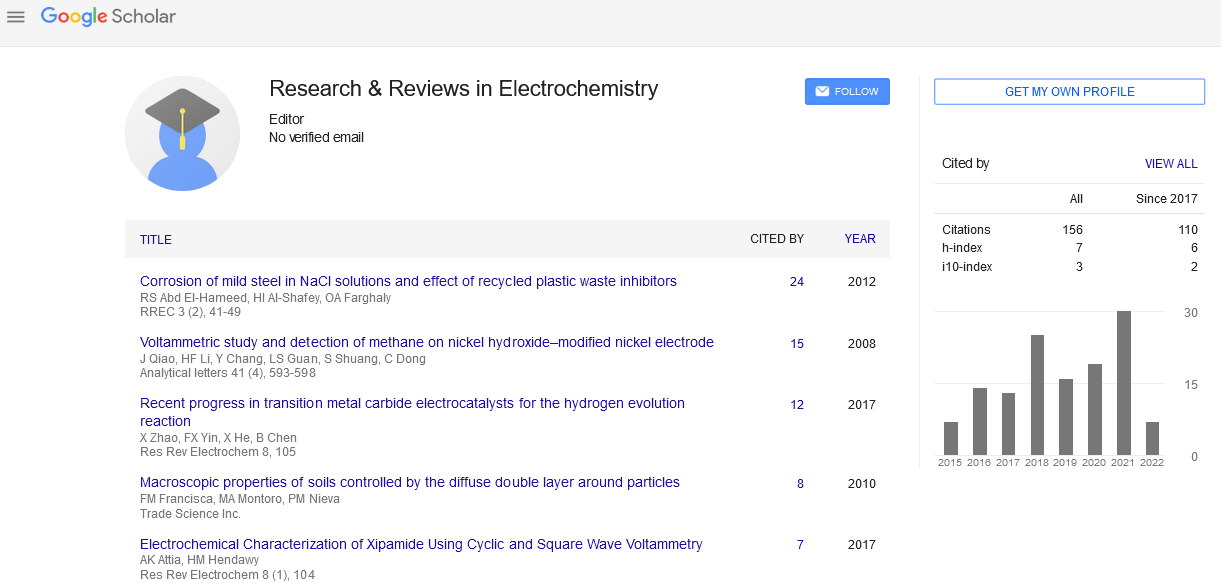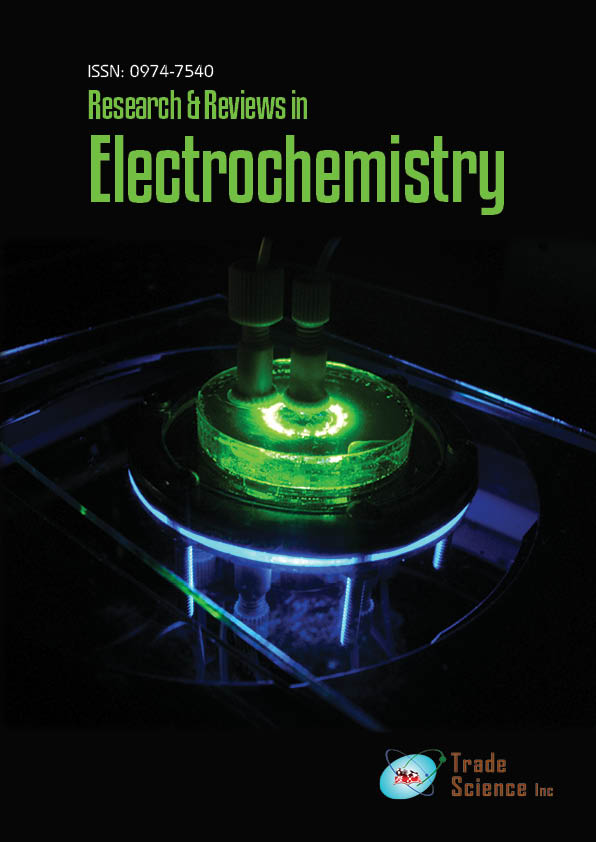Viewpoint
, Volume: 12( 4) DOI: 10.37532/0974-7540.22.12.4.246Properties and Electro catalytic Applications of Carbon Quantum Dots
- *Correspondence:
- Sara Brown
Editorial Office, Research and Reviews in Electrochemistry, UK
E-mail:electro.med@scholarres.org
Received: 1-July-2022; Manuscript No. tsrre-22-72676; Editor Assigned: 15-July-2022; PreQC No. tsrre-22-72676 (PQ); Reviewed: 23-July2022; QC No. tsrre-22-72676 (Q); Revised: 26-July-2022; Manuscript No. tsrre-22-72676 (R); Published: 27-July-2022, DOI No. 10.37532/0974-7540.22.12.4.246
Citation: Brown S. Properties and Electrocatalytic Applications of Carbon Quantum Dots. Res Rev Electrochem. 2022;12(4):246.
Abstract
Luminescent Carbon Quantum Dots (CQDs) are a new type of nano-carbon material that has received a lot of attention recently, especially in chemical sensors, bio-imaging, nanomedicine, solar cells, Light-Emitting Diode (LED) and electrocatalysis. CQDs can be made easily and cheaply using a variety of techniques, including the arc-discharge method, microwave pyrolysis, hydrothermal method, and electrochemical synthesis. CQDs have outstanding physical and chemical properties such as high crystallisation, good dispersibility, and photoluminescence. CQDs, in particular, have improved electrical conductivity and catalytic activity due to their small size, superconductivity, and rapid electron transfer. Furthermore, CQDs have a lot of functional groups on the surface, which could make it easier to make multi-component electrical active catalysts. Interactions within these multi-component catalysts may improve catalytic performance further by promoting charge transfer, which is important in electrochemistry. Recent studies on CQDs have concentrated on their fluorescence and photocatalytic properties. This review will summarise the major advances of CQDs in synthetic methods, excellent physical and electronic properties, and applications in electrocatalysis, such as Oxygen Reduction Reaction (ORR), Oxygen Revolution Reaction (OER), Hydrogen Evolution Reduction (HER), and CO2 Reduction Reaction (CO2RR).
Introduction
Carbon-based nanomaterials such as Carbon Nanotubes (CNTs), fullerenes, graphene, and nanodiamonds have received a great deal of attention in recent years. However, nanodiamond preparation and separation are difficult; CNTs, fullerenes, and graphene have low water solubility and difficulty providing strong fluorescence in visible areas, limiting their application. Carbon Quantum Dots (CQDs) are zero-dimensional carbon-based nanomaterials distinguished by their small size and relatively strong fluorescence. The main research objects in the field of CQDs are Graphene Quantum Dots (GQDs), Carbon Nanodots (CNDs), and Polymer Dots (PDs). CQDs are also referred to as carbon dots in some cases (CDs). GQDs, CNDs, and PDs are similar in size and photoelectrochemical properties, but differ in internal structure and surface chemical groups. They are monodisperse spherical nanoparticles with a carbon-based skeleton and a large number of oxygen-containing groups on the surface. To make these materials fluorescent, the size and surface chemical groups must be carefully adjusted to fine-tune the electronic structures. CQDs not only inherit the excellent optical properties of traditional semiconductor quantum dots, but they also compensate for the deficiencies of traditional materials in terms of cytotoxicity, environmental hazard, and biohazard. CQDs also have good water solubility, chemical stability, and photo-bleaching resistance, as well as ease of surface functionalization and large-scale preparation. Since its discovery by researchers in 2004, it has piqued the interest of scientists in a variety of fields, including biology, chemical sensing, nanomedicine, and photoelectrocatalysis. A significant amount of progress has been made in the synthesis and application of CQDs as of now. The synthetic methods and physical/chemical properties of these luminescent CQDs will be introduced first in this review. Though the electrocatalytic properties of CQDs have been studied in recent years, there are currently no specific reviews that focus on CQD applications in electrocatalysis. As a result, we discuss in great detail the applications of CQDs in several electrocatalytic reactions, including Oxygen Reduction Reaction (ORR), Oxygen Evolution Reaction (OER), Hydrogen Evolution Reduction (HER), and CO2 Reduction Reaction (CO2RR), as well as the benefits they may bring to these aspects.
Physical and Chemical Properties
Analysts are having trouble determining the physicochemical qualities of nanoparticles and looking into their structure and functional links. Their ability to fully explore the nanoscale realm is a major limitation: Different depiction tactics are based on different real characteristics, resulting in a half-baked image of nanoparticle attributes. The purposeful quantities of nanoparticles can be directly influenced by the representation approaches. Nanoparticles are utilized in a variety of preparations, including micelles, metal (oxide), and synthetic polymers.
Absorbance
The optical absorption peaks of CQDs in the UV-visible region are typically estimated as π-π* transition of sp2 conjugated carbon and n-π* transition of hybridization with heteroatoms such as N, S, P, and so on. Surface passivation or modification can be used to manipulate the absorption property. Jiang et al. used three isomers of phenylenediamines to create red, green, and blue luminescent CQDs via a simple hydrothermal method. The UV-visible absorption spectra of the CQDs obtained showed a similar pattern. Interestingly, the absorption transitions of these three CQDs were red-shifted, indicating that the CQDs' electronic bandgaps were smaller than those of their precursors.
Photoluminescence
Photoluminescence is one of the most intriguing characteristics of CQDs, both in terms of fundamental research and practical application. In general, the distinct dependence of the emission wavelength and intensity on the PL for CQDs is a consistent feature. The optical selection of nanoparticles with different sizes or CQDs with different emissive traps on the surface could explain this unusual phenomenon. The broad and excitation-dependent PL emission spectrum studied the emission behaviours of CQDs under an irradiation at 470 nm wavelength with various concentrations to reflect the variation of particle size and PL emission. The PL strength of the CQDs solution increased first and then decreased as concentration increased.
Electroluminescence
Because semiconductor nanocrystals are well-known for exhibiting Electroluminescence (ECL), it should come as no surprise that CQDs have sparked a flurry of interest in ECL research that can be applied in electrochemical fields. Zhang described a CQDsbased Light-Emitting Diode (LED) device in which the driving current controls the emission colour. Under different working voltages, color-switchable ECL from the same CQDs ranging from blue to white was observed. To better understand the luminescence mechanism of CQDs, the researchers proposed two models based on the conjugated p domain's band gap emission and the edge effect caused by another surface defect. The Quantum Confinement Effect (QCE) of p-conjugated electrons in the sp2 atomic framework determines the PL characteristics of the fluorescence emission of CQDs from the conjugated p domain, which can be adjusted by their size, edge configuration, and shape. Fluorescence emission of CQDs associated with surface defects is caused by sp2 and sp3 hybridised carbon, as well as other surface defects of CQDs, and fluorescence intensity and peak position are also related to this defect.
Carbon Quantum Dots Used in Electro catalysis
Because of the looming environmental challenges, carbon-based materials, particularly CQDs, have piqued the interest of many in the fields of energy conversion and storage. The abundant functional groups (-OH, -COOH, -NH2, and so on) on the surface of CQDs can act as active coordination sites for transition metal ions. The electrocatalytic performance of heteroatom doped CQDs with multiple components may be improved further by promoting electron transfer via internal interactions
Oxygen reduction reaction
ORR has received a lot of attention in recent years as a key route for metal-air batteries and fuel cells. CQDs are stable in water and several polar organic solvents due to nitrogen and oxygen functional groups, and they are convenient for multi-component photoelectric chemical reactions such as ORR. Jin et al. created a new carbon-based ORR catalyst by hybridizing GQDs with Graphene Nanoribbons (GNR) in situ using a one-step reduction reaction. The obtained GQDs-GNR catalyst demonstrated excellent ORR performance and durability in alkaline conditions. By decorating a zero-dimension GQDs particle on the surface of a two-dimension GQDs nanosheet, Liu created a multidimensional N-GQDs hybrid with tunable PL emission. The resulting N-GQDs demonstrated excellent catalytic ORR performance in basic media. When compared to pristine s-g-C3N4 and GQDs, the resulting s-g-C3N4@GQDs nanohybrid demonstrated significantly improved catalytic ORR activity, indicating the promising potential of CQDs in electro catalytic applications
Oxygen evolution reaction
CQDs combined with Transition Metal (TM)-based compounds may improve the catalytic performance of TM-based catalysts. It www.tsijournals.com | July-2022 3 has been reported that the CoP/CQDs composite exhibits better OER activity in alkaline electrolytes than pure CoP, with an over potential of 400 mV. The abundance of functional groups, small size, good conductivity, and rapid electron transfer of CQDs all contribute to the improved electrical catalytic performance of CoP/CQDs composite. Tang described a promising CQDs/NiFe-LDH nanocomposite catalyst synthesised via rational co-precipitation followed by solvothermal treatment. The CQDs/NiFe-LDH catalyst as obtained demonstrated excellent OER electrochemical activity with a low over potential of 235 mV at 10 mA cm-2 and good durability in 1 M KOH. The increased conductivity of NiFe-LDH and the favorable electron transfer between CQDs and NiFe-LDH.
CO2 reduction reaction
In recent years, electrochemically converting the excess carbon dioxide produced by the combustion of fossil fuels back to the natural carbon cycle has emerged as a hotspot of new energy research. Fu and Zhu devised a novel method for producing nitrogendoped graphitic quantum dots-wrapped single-crystalline Au nanoparticles (NGQDs-SCAu NPs) for CO2 reduction. The synthesised NGQDs-SCAu NPs demonstrated improved CO2 reduction performance, with an onset potential of 0.15 V vs. reversible hydrogen electrode (RHE) and over potential of only 0.04 V. Furthermore, the faradaic efficiency of the NGQDs-SCAu NPs CO product was 0.4 V lowers than that of the bare SCAu catalyst. The synergetic effect between SCAu and NGQDs for the enhancement of COOH* adsorption on the pyridine N site of NGQDs was attributed to the improved catalytic activity of NGQDsSCAu NPs for reducing CO2 into CO.

